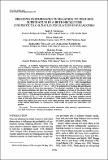Por favor, use este identificador para citar o enlazar a este item:
http://hdl.handle.net/10261/39779COMPARTIR / EXPORTAR:
 SHARE
BASE SHARE
BASE
|
|
| Visualizar otros formatos: MARC | Dublin Core | RDF | ORE | MODS | METS | DIDL | DATACITE | |

| Campo DC | Valor | Lengua/Idioma |
|---|---|---|
| dc.contributor.author | Donázar, José A. | - |
| dc.contributor.author | Ceballos, Olga | - |
| dc.contributor.author | Travaini, Alejandro | - |
| dc.contributor.author | Rodríguez, Alejandro | - |
| dc.contributor.author | Funes, Martín | - |
| dc.contributor.author | Hiraldo, Fernando | - |
| dc.date.accessioned | 2011-09-21T10:05:15Z | - |
| dc.date.available | 2011-09-21T10:05:15Z | - |
| dc.date.issued | 1994-12 | - |
| dc.identifier.citation | The Condor 96:994—1002 (1994) | es_ES |
| dc.identifier.uri | http://hdl.handle.net/10261/39779 | - |
| dc.description.abstract | In northern Argentinean Patagonia, Buff-necked Ibis (Theristicus caudatus) nest on different substrata: cliffs, trees, and marsh vegetation. According to the ideal-free distribution hypothesis, this polymorphism may be due to the occupation of the best breeding habitats by dominant individuals and the relegation of the subdominant birds to marginal substrata with a lower probability of achieving successful breeding. We investigated whether there were any variations in the breeding performance among colonies and whether these variations were related to the breeding substratum. Laying date varied from the third week of September to the last week of October, laying occurring earlier in colonies at lower elevations. Clutch size per colony varied between 1.8 and 2.0 (X 1.9, n = 106), but significant differences were not detected among colonies. Brood size per colony varied significantly, ranging between 1.3 and 2.0 (x = 1.8, n = 164). The substratum of breeding did not influence variations in any of these three parameters. The physical condition of the chicks did not vary among substrata, but there was inter-colony variation in broods of two chicks. Daily rates of nest losses were similar among colonies reaching 6.2% (n 856) during incubation and 1.4% (n = 966) during the nestling period. Brood reduction was low; the daily mortality rate of chicks (0.7%, n 934) did not vary among colonies. The most common known cause of nest and chick losses was predation. These results indicate that breeding success varied only slightly from one colony to the other and that these variations are independent of the nesting substratum. In consequence, birds would not prefer one substratum over another. | es_ES |
| dc.language.iso | eng | es_ES |
| dc.publisher | University of California Press | es_ES |
| dc.rights | openAccess | es_ES |
| dc.subject | Nest-site polymorphism | es_ES |
| dc.subject | habitat saturation | es_ES |
| dc.subject | Daily mortality | es_ES |
| dc.subject | Reproductive success | es_ES |
| dc.subject | Buff-necked Ibis | es_ES |
| dc.subject | Theristicus caudatus | es_ES |
| dc.subject | Argentina | es_ES |
| dc.title | Breeding Performance in Relation to Nest-Site Substratum in a Buff-Necked Ibis (Theristicus Caudatus) Population in Patagonia | es_ES |
| dc.type | artículo | es_ES |
| dc.description.peerreviewed | Peer reviewed | es_ES |
| dc.relation.publisherversion | http://www.jstor.org/stable/1369108 | es_ES |
| dc.type.coar | http://purl.org/coar/resource_type/c_6501 | es_ES |
| item.openairecristype | http://purl.org/coar/resource_type/c_18cf | - |
| item.fulltext | With Fulltext | - |
| item.cerifentitytype | Publications | - |
| item.openairetype | artículo | - |
| item.languageiso639-1 | en | - |
| item.grantfulltext | open | - |
| Aparece en las colecciones: | (EBD) Artículos | |
Ficheros en este ítem:
| Fichero | Descripción | Tamaño | Formato | |
|---|---|---|---|---|
| Donázar_Condor_94.pdf | 749,01 kB | Adobe PDF |  Visualizar/Abrir |
CORE Recommender
Page view(s)
420
checked on 18-abr-2024
Download(s)
1.392
checked on 18-abr-2024
Google ScholarTM
Check
NOTA: Los ítems de Digital.CSIC están protegidos por copyright, con todos los derechos reservados, a menos que se indique lo contrario.
